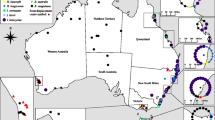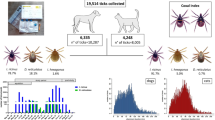Abstract
Voluntary collections of ticks from domestic dogs and cats by veterinary practitioners across Florida, USA, were conducted over a 10 month period. Of the 1337 ticks submitted, five species of ixodid ticks were identified and included Rhipicephalus sanguineus, Amblyomma americanum, A. maculatum, Dermacentor variabilis, and Ixodes scapularis. Most ticks were collected from dogs (98.4 %) with the most predominant species being R. sanguineus (94.3 %). Of the ticks collected from cats (1.6 %), A. americanum were the most common (74 %). Only R. sanguineus were collected throughout the state, with the other species collected only in central and north Florida. The tick species collected from dogs and cats represent a risk to these domestic species as well as associated humans for a range of tick-borne diseases in Florida.

Similar content being viewed by others
References
Akucewich LH, Philman K, Clark A, Gillespie J, Kunkle G, Nicklin CF, Greiner EC (2002) Prevalence of ectoparasites in a population of feral cats from north central Florida during the summer. Vet Parasitol 109:129–139
Allan SA, Simmons L, Burridge MJ (2001) Ixodid ticks on white-tailed deer and feral swine in Florida. J Vector Ecol 26:93–102
Beall MC, Alleman AR, Breitschwerdt EB, Cohn LA, Couto CG, Dryden MW, Guptill LC, Iazbik C, Kania SA, Lathan P, Little SE, Roy A, Sayler KA, Stillman BA, Welles EG, Wolfson W, Yabsley MJ (2012) Seroprevalence of Ehrlichia canis, Ehrlichia chaffeensis and Ehrlichia ewingii in dogs in North America. Parasite Vector 5:29
Beichel E, Petney TN, Hassler D, Bruckner M, Maiwald M (1996) Tick infestation patterns and prevalence of Borrelia burgdorferi in ticks collected at a veterinary clinic in Germany. Vet Parasitol 65:147–155
Bishopp FC, Trembley HL (1945) Distribution and hosts of certain North American ticks. J Parasitol 31:1–54
Blouin EF, Kocan AA, Glenn BL, Kocan KM, Hair JA (1984) Transmission of Cytauxzoon felis Kier, 1979 from bobcats, Felis rufus (Schreber), to domestic cats by Dermacentor variabilis. J Wildl Dis 20:241–242
Bowman D, Little SE, Lorentzen L, Shields J, Sullivan MP, Carlin EP (2009) Prevalence and geographic distribution of Dirofilaria immitis, Borrelia burgdorferi, Erhlichia canis, and Anaplasma phagocytophilum in dogs in the United States: results of a national clinic-based serological survey. Vet Parasitol 160:138–148
Breitschwerdt EB, Abrams-Ogg A, Hancock S, Cowan S, Clooten J, Heagart B (2001) Molecular evidence of Ehrlichia canis infection in cats from North America. J Vet Intern Med 15:276
Butt MT, Bowman D, Barr MC, Roelke ME (1991) Iatrogenic transmission of Cytauxzoon felis from a Florida panther (Felix concolor coryi) to a domestic cat. J Wildl Dis 27:342–347
Clark KL, Wills W, Tedders SH, Williams DC (1996) Ticks removed from dogs and animal care personnel in Orangeburg County, South Carolina. J Agromed 3:45–55
Clifford CM, Anastos G (1960) the use of chaetotaxy in the identification of larval ticks (Acarina: Ixodidae). J Parasitol 46:567–578
Dantas-Torres F (2008) The brown dog tick, Rhipicephalus sanguineus (Latreille, 1806) (Acari: Ixodidae): from taxonomy to control. Vet Parasitol 152:173–185
Dantas-Torres F, Melo MF, Figueredo LA, Brandao-Filho SP (2009) Ectoparasite infestation on rural dogs in the municipality of Sao Vincente Ferrer, Pernambuco, Northeastern Brazil. Rev Bras Parasitol Vet 1:75–77
Dennis DT, Nekomoto TS, Victor JC, Paul WS, Piesman J (1998) Reported distribution of Ixodes scapularis and Ixodes pacificus (Acari: Ixodidae) in the United States. J Med Entomol 35:629–638
Diniz PPVP, Beall MJ, Omark K, Chandrashekar R, Daniluk DA, Cyr KE, Koterski JF, Robbins RG, Lalo PG, Hegarty BC, Breitschwerdt EB (2010) High prevalence of tick-borne pathogens in dogs from an Indian Reservation in Northeastern Arizona. Vector borne zoonotic Dis 10:117–123
Eberhardt JM, Neal K, Shackelford R, Lappin MR (2006) Prevalence of selected infectious disease agents in cats from Arizona. J Feline Med Surg 8:164–168
Eiden AL, Kaufman PE, Oi FM, Allan SA, Miller RJ (2015) Detection of permethrin resistance and fipronil tolerance in Rhipicephalus sanguineus (Acari: Ixodidae) in the United States. J Med Entomol 52:429–436
Ewing SA, Panciera RJ (2003) American canine hetatozoonosis. Clin Micro Rev 16:688–697
Foldvari G, Farkas R (2005) Ixodid tick species attaching to dogs. Vet Parasitol 109:129–139
Forrester DJ, McLaughlin GS, Telford SR Jr, Foster GW, McCown T (1996) Ectoparasites (Acari: Mallopha, Anoplura, Diptera) of white-tailed deer, Odocoileus virginianus, from southern Florida. J Med Entomol 33:96–101
Fritz CL, Kjemtrup AM (2003) Lyme Borreliosis. J Am Vet Med Assoc 223:1261–1270
Goldberg M, Rechav Y, Durden LA (2002) Ticks parasitizing dogs in northwestern Georgia. J Med Entomol 39:112–114
Green GE (2011) Infectious diseases of the dog and cat, 4th edn. Elsevier, Philadelphia
Greene CE, Breitschwerdt EB (1998) Rocky Mountain spotted fever, Q fever and typhus. In: Greene CE (ed) Infectious diseases of the dog and cat. W.B. Saunders, Philadelphia, pp 155–165
Greiner EC, Humphrey PP, Belden RC, Frankenberger WB, Austin DH, Gibbs EPJ (1984) Ixodid ticks on feral swine in Florida. J Wildl Dis 20:114–119
Keirans JE, Durden LA (1998) Illustrated key to nymphs of the tick genus Amblyomma (Acari: Ixodidae) found in the United States. J Med Entomol 35:489–495
Keirans JE, Litwak TR (1989) Pictorial key to the adults of hard ticks, family Ixodidae (Ixodida: Ixodoidea), east of the Mississippi river. J Med Entomol 26:435–448
Koch HG (1982) Seasonal incidence and attachment sites of ticks (Acari: Ixodidae) on domestic dogs in southeastern Oklahoma and northwestern Arkansas, USA. J Med Entomol 19:293–298
Kordick SK, Breitschwerdt E, Hegarty BC, Southwick KL, Colitz CM, Hancock SI, Bradley JM, Fumbough R, McPherson JT, MacCormack JN (1999) Coinfection with multiple tick-borne pathogens in a walker hound kennel in North Carolina. J Clin Microbiol 37:2631–2638
Lappin MR, Prause LC, Jensen W (2005) Prevalence of select infectious diseases in dogs and cats from villages in Quintana Roo, Mexico. J Vet Internal Med 17:425
Little SE, Beall MJ, Bowman DD, Chandrashekar R, Stamaris J (2014) Canine infection with Dirofilaria immitis, Borrelia burgdorferi, Anaplasma spp., and Ehrlichia spp. in the United States, 2010–2012. Parasite Vector 7:257–265
Luria BJ, Levy JK, Lappin MP, Breitschwerdt EB, Legendre AM, Hernandez JA, Gorman SO, Lee IT (2004) Prevalence of infectious diseases in feral cats in Northern Florida. J Feline Med Surg 6:287–296
Mendes-de-Almeida F, Crissiuma AL, Gershony LC, Willi LMV, Paiva JP, Guerrero J, Labarthe N (2011) Characterization of ectoparasites in an urban cat (Felis catus Linnaeus, 1758) population of Rio de Janeiro, Brazil. Parasitol Res 108:1431–1435
Ndip LM, Ndip RN, Ndive VE, Awuh JA, Walker DH, McBride JW (2007) Ehrlichia species in Rhipicephalus sanguineus ticks in Cameroon. Vector Borne Zoonotic Dis 7:221–227
Ndip LM, Ndip RN, Esemu SN, Walker DH, McBride JW (2010) Predominance of Ehrlichia chaffeensis in Rhipicephalus sanguineus ticks from kennel-confined dogs in Limbe, Cameroon. Exp Appl Acarol 50:163–168
Ogden NH, Cripps P, Davison CC, Owen G, Parry JM, Timms BJ, Forbes AB (2000) The ixodid tick species attaching to domestic dogs and cats in Great Britain and Ireland. Med Vet Entomol 14:332–338
Otranto D, Lia RP, Cantacessi C, Galli G, Paridies P, Mallia E, Capelli G (2005) Efficiency of a combination of imidacloprid 10%/permethrin 50% versus fipronil 10%/(S)-methoprene 12%, against ticks in naturally infected dogs. Vet Parasitol 130:293–304
Reichard MV, Baum KA, Cadenhead SC, Snider TA (2008) Temporal occurrence and environmental risk factors associated with cytauxzoonosis in domestic cats. Vet Parasitol 152:314–320
Reichard MV, Meinkoth JH, Edwards AC, Snider TA, Kocan KM, Blouin EF, Little SE (2009) Transmission of Cytauxzoon felis to a domestic cat by Amblyomma americanum. Vet Parasitol 161:110–115
Rizzi TE, Reichard MV, Cohn LA, Birkenheuer AJ, Taylor JD, Meinkoth JH (2015) Prevalence of Cytauxzoon felis infection in healthy cats from enzootic areas in Arkansas, Missouri, and Oklahoma. Parasite Vector 8:13–18
Rotstein DS, Taylor SK, Harvey JW, Bean J (1999) Hematologic effects of cytauxzoonosis in Florida panthers and Texas cougars in Florida. J Wildl Dis 35:613–617
Shaw SE, Day MJ, Birtles RJ, Breitschwerdt EB (2001a) Tick-borne infectious diseases of dogs. Trends Parasitol 17:74–80
Shaw SE, Birtles RJ, Day MJ (2001b) Arthropod-transmitted infectious diseases of cats. J Feline Med Surg 3:193–209
Shimada Y, Inokuma H, Beppu T, Okuda M, Onishi T (2003) Survey of ixodid tick species on domestic cats in Japan. Vet Parasitol 111:231–239
Smith JS (1977) A survey of ticks infesting white-tailed deer in 12 southeastern states, M.S. thesis, University of Georgia, (inter-library loan)
Stubbs CJ, Lappin MR, Holland CJ, Wheeler SL (1998) Feline ehrlichiosis. J Vet Internal Med 12:230
Taboada J, Levy MG, Breitschwerdt EB (1991) Seroprevalence of babesiosis in greyhounds in Florida. J Am Vet Med Assoc 200:47–50
Taylor DJ (1951) The distribution of ticks in Florida, M.S. thesis, University of Florida, (inter-library loan)
Wehinger KA, Roelke ME, Greiner EC (1995) Ixodid ticks from panthers and bobcats in Florida. J Wildl Dis 31:480–485
Yabsley MJ, Murphy SM, Cunningham MW (2006) Molecular detection and characterization of Cytauxzoon felis and a Babesia species in cougars in Florida. J Wildl Dis 42:366–374
Zahler M, Schein E, Rinder H, Gothe R (1998) Characteristic genotypes discriminate between Babesia canis isolates of differing specificity and pathogenicity to dogs. Parasitol Res 84:544–548
Acknowledgments
The authors would like to thank participating veterinary practitioners and their staff for tick collection and submission, Merial, Inc., for assistance in distribution of the survey, and Toni McIntosh for her assistance in tick identification.
Author information
Authors and Affiliations
Corresponding author
Rights and permissions
About this article
Cite this article
Burroughs, J.E., Thomasson, J.A., Marsella, R. et al. Ticks associated with domestic dogs and cats in Florida, USA. Exp Appl Acarol 69, 87–95 (2016). https://doi.org/10.1007/s10493-016-0019-4
Received:
Accepted:
Published:
Issue Date:
DOI: https://doi.org/10.1007/s10493-016-0019-4




